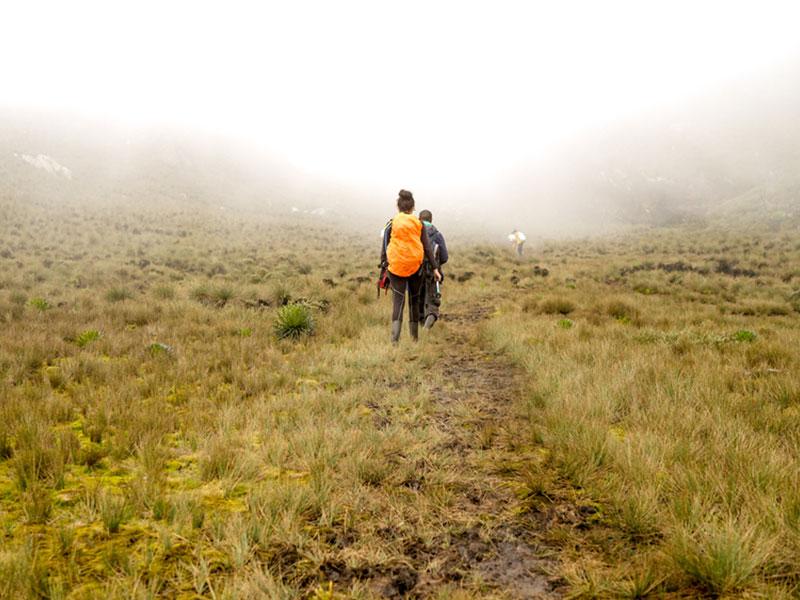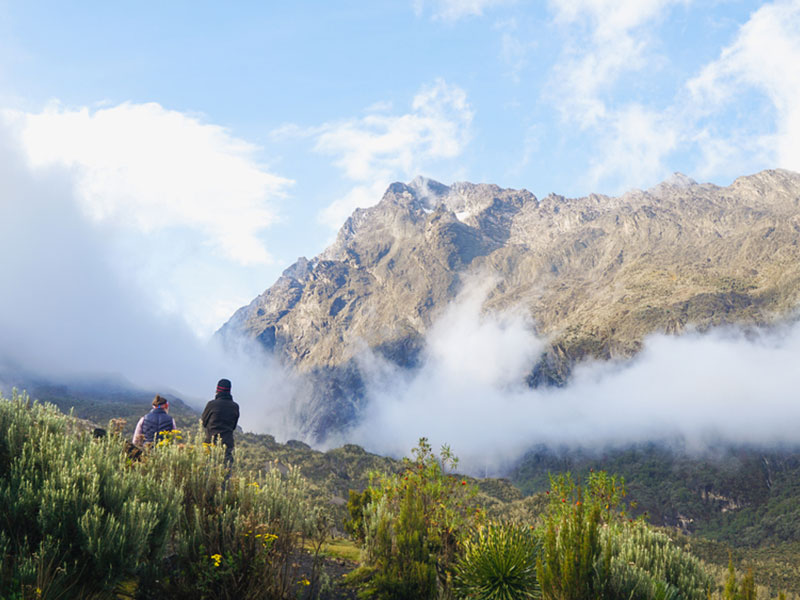THE MYSTICAL CHALLENGE
Back in AD150, the geographer Ptolemy wrote of a snow-capped mountain range in the heart of Africa, which he claimed represented the source of the Nile and which he named Montes Lunae – the Mountains of the Moon. Seventeen centuries passed before the explorer Henry Stanley located such a mountain in western Uganda and established that, though Lake Victoria is the primary source of the Nile, the great river is also supplied with equatorial meltwaters. Stanley mapped the range as ‘Rwenzori’, a local name that he recorded as meaning “ rain maker ” or “ cloud-king.” In the years since Stanley’s 1888 visit, the Rwenzori has become established as one of Africa’s great mountaineering adventures, offering the chance to ascend snow peaks and walk on equatorial glaciers that represent the highest and most intriguing source of the Nile.
The high Rwenzori consists of six distinct mountains, Stanley, Speke, Baker, Emin, Gessi and Savioa. Mt. Stanley’s 5109m Margherita Peak, which stands on the Uganda-Congo border, is the third highest point in Africa. The Ugandan section of the mountain was gazette as the 995km2Rwenzori Mountains National Park in 1991 and was recognized as a World Heritage Site in 1994.
The park is home to 18 mammal species, 217 bird species, 9 species of reptiles and 6 species of amphibians. Large mammals, including elephant, buffalo, giant forest hog, bushbuck, chimpanzee and leopard are present in the forest zone, but are rarely seen. Rwenzori is also home to 217 recorded bird species.


ACTIVITIES AND ATTRACTIONS
Mountain Trekking
Three routes ascend to the high Rwenzori. Rwenzori Trekking Services (RTS) operates the Kilembe Trail which enables nine-day expeditions to summit Mount Stanley and a shorter, six day option to the more accessible, but equally scenic, Mt. Luigi da Savoia. The Nyakalengija-based Rwenzori Mountaineering Services runs the Central Circuit which reaches and returns from Mount Stanley in seven days. The Bukurungu Trail ascends from Kitumba to Mount Gessi. The mountain is best climbed during the drier months of January and June-July.
Peak Climbing
The highest peaks on the Rwenzori’s six mountains can all be climbed. The most popular is the 5109m Margherita, the highest point on Mount Stanley, Speke, and Baker is a physically demanding activity, frequently in bad weather, and for which specialist equipment and technical experience is required. Age is no barrier however; the oldest person to reach the Margherita Peak was Ms Beryl Park, aged 78! An ascent of Mount Stanley requires a minimum of seven days on the mountain.
Hiking
The real appeal of the Rwenzori is the opportunity to hike through superb mountain scenery enlivened by equatorial snow and outlandish vegetation. With this in mind, shorter hikes are becoming increasingly popular. A detour on the Kilembe Trail reaches the 4627m Mt. Luigi da Savoia which offers afroalpine vegetation, patches of equatorial snow and, weather permitting, grandstand views towards Mount Stanley. Nyakalengija Trailhead offers a two-day hike to the scenic Lake Mahoma in the bamboo forest. The Kazingo Trail enables a day-long traverse of the north Rwenzori ridge between the Fort Portal plateau and Bundibugyo town in the Semliki Valley on the West side of the mountain.
Forest Walks and Birding
The forest zone, which occupies the lower contours of the national park, can be visited as a day walk from the Kilembe and Nyakalengija trailheads. Conveniently for birders, the park’s birdlife is concentrated in this relatively accessible area. Species of interest include the Rwenzorituraco and Rwenzori double collared sunbird, Rwenzoribatis, handsome francolin, strange weaver, Rwenzori nightjar, Archer’s robin-chat and red-throated alethe. Look out for other localized rarities such as the three horned chameleon and Rwenzoricolobus monkey.
ACCESS TO THE PARK
The Rwenzori Mountains lie along the Uganda-Congo border in western Uganda. The main trailheads are accessed from the tarmac Fort Portal-Kasese road. Kasese, is 375km from Kampala via Fort Portal (which is 300km from Kampala) and 450km passing via Mbarara. The Kilembe Trailhead lies at the head of the Nyamwamba Valley, 15km west of Kasese. The Central Circuit Trailhead is located in the Mubuku Valley at Mihunga, 22km from the Fort Portal-Kasese road, 25km north of Kasese. For the Bukurungu Trail, turn off the main road at Nyakigumba, midway between Kasese and Fort Portal, and drive for 6km to the trailhead at Katebwa. Air transport can also be arranged to Kasese from Kampala’s Kajjansi airfield or Entebbe International Airport.
